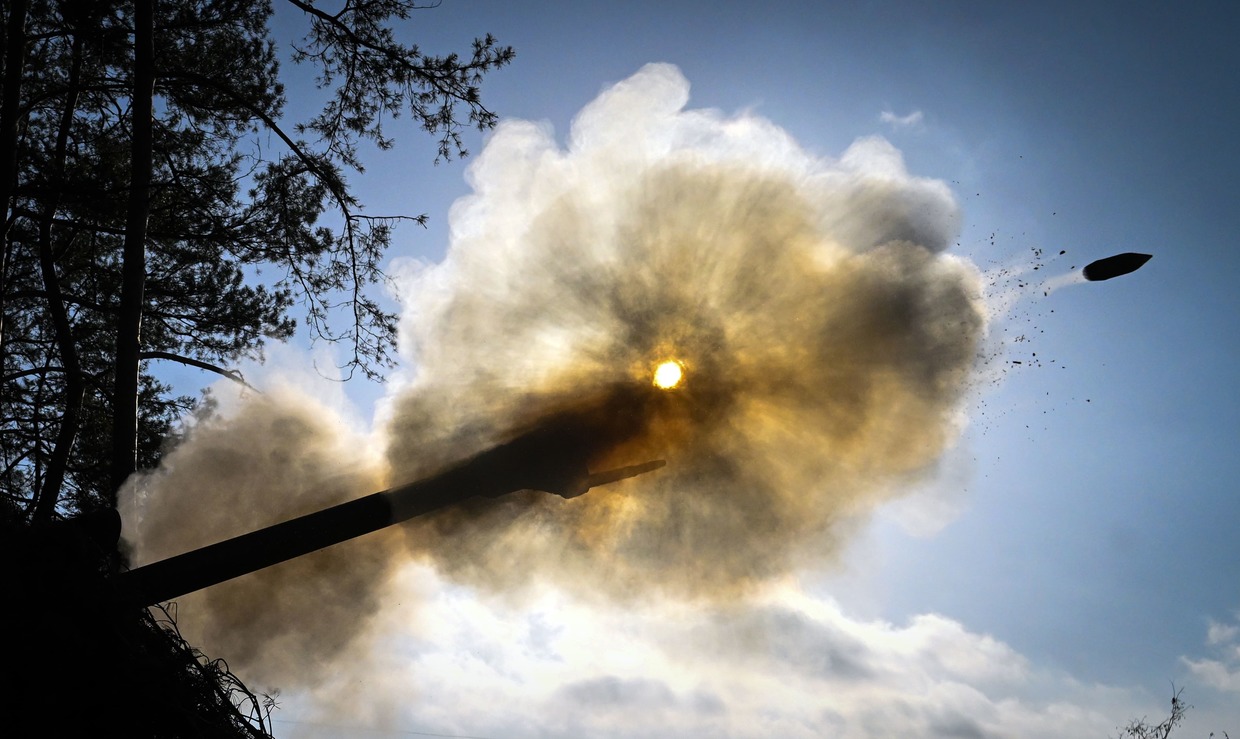Suicide mission: As 2023 draws to a close, the Ukrainian army’s last ‘counteroffensive’ advance has stalled

In order to mislead their Russian opponents, the Ukrainian command devised a risky and unorthodox plan, earlier this year, in an attempt to gain a number of tactical footholds on the left bank of the Dnieper river in Kherson Region. It resulted in a bloodbath near the village of Krynki, which left their marines demoralized.
Meanwhile, the results did they did achieve were likely to be lost, due to the elements.
Broader Context
The current front line in Kherson Region was formed in November 2022, when Russian forces withdrew from the eponymous regional capital city. After that, the intensity of the fighting decreased, mainly being reduced to artillery exchanges, kamikaze drone attacks and subversive and reconnaissance missions by both sides against enemy positions on the opposite bank of the Dnieper.
A little later, the bloody battles for the river's downstream islands began, which were tactically useless, but caused enormous carnage. The Armed Forces of Ukraine (AFU) used waterborne vehicles to seize several of them and improve their positions. However, due to the swampy terrain, they were not able to set up effective defenses, and the Russian Army used not only infantry and special operations units but also aircraft to retake the islands.
These battles, which cost the lives of so many troops on both sides, were later rendered worthless when the Kakhovka Dam was destroyed in early June 2023, causing extensive flooding of all areas downstream from the reservoir of the same name. This happened just as Ukrainian troops started to advance on Melitopol and Berdyansk in an attempt to reach the Sea of Azov, which would have split Russian forces into two parts – Crimean and Donbass groups.
Russia’s Vostok group of forces bore the brunt of the Ukrainian attack last summer. They defended the front line from the Kakhovka Reservoir to the approaches to Novomikhailovka, a Ukrainian-controlled settlement in the Donbass. The Dnepr, a group of troops deployed along the river, was supposed to reinforce Vostok if necessary. Thus, the Ukrainian command tried to prevent the Russian troops on the left bank of the Dnieper from being redeployed to Zaporozhye Region. That’s how Ukraine’s landing operation targeting the Russian-controlled areas on the Dnieper began.
Assault Operations of the AFU
The extended front line along the Dnieper put the Russians at a disadvantage, as a lack of troops made it impossible to establish a solid first line of defense that would effectively prevent any enemy attempts to cross the river. Therefore, the Russian defense strategy was largely based on forward troops, a fortified second line of defense in the rear, and an operational reserve unit. The latter was intended to counterattack any landing forces and prevent them from gaining a strong beachhead, which would pose a threat to the Russian Army.
The Ukrainian plan, on the other hand, included several maneuvers and attacks on various Russian positions in order to overwhelm Russian defense capabilities and deplete the operational reserves of the Dnepr group of forces.

At first the tactics of the AFU served to divert the attention of the Russian command from the battles near Rabotino and the Vremevsky bulge. But in the autumn, after the defeat in the ‘Priazovye Battle’ and the transfer of four Ukrainian marine brigades from the Vremevsky bulge to Kherson Region, the landing operation itself became the main focus. As a result, by the end of 2023, Kherson Region remains the only frontline section where the AFU retains the initiative.
The Ukrainians seized their first bridgeheads in the marshy area of the Dnieper estuaries near the Antonovsky road-rail bridge. At first Kiev's official spokesmen kept quiet about these battles, asking for silence, but on August 29, the Ukrainian flag was raised over the ruins of the Antonovsky bridge. In addition, they seized the so-called Antonovsky dachas.
Kiev's forces had no objective way to extend the bridgehead inland: behind the Antonovsky road bridge lay the relatively large village of Alyoshki, which still had to be reached through swampy terrain. In October, the Ukrainians attempted to storm Peschanovka, south of the railway bridge, but were unsuccessful.
Thus, the actions of the AFU during all this time focused on sabotage, reconnaissance, and containment. The most typical example is the fighting near Kazachi Lageri, where Ukrainian DRGs ambushed the Russian military in August 2023. The area was subsequently cleared of saboteurs.

Around October 19, after a series of unsuccessful attacks on Poima and Peschanovka, Ukrainian marines redeployed from around the Vremevsky bulge were able to gain a foothold near the village of Krynki. The Ukrainian side ignored the fighting in the area for a long time. In particular, the Ukrainian military analysis channel DeepState recommended waiting for official information until October 30, when “taking into account the media resonance” they updated their map of military operations, adding a gray zone in the area. And so, on November 17, Kiev officially announced the establishment of several bridgeheads on the left bank of the Dnieper.
Initially, the Ukrainian forces had some success and even managed to penetrate deep into the forests south of Krynki, but the Russian army responded by shelling and bombing the bridgehead, as well as moving maneuver reserves into the area, including airborne troops.
Prospects
According to Ukrainian military expert Konstantin Mashovets, the Russian Dnepr group of forces is the second largest group of Russian troops in the theater of operations, amounting to more than 73,000 men plus a large number of tanks, armored vehicles, and artillery, including multiple launch rocket systems. Despite the wide front that this group must cover, countering it requires a commensurate force from the Ukrainian army – much larger than four marine brigades, one artillery brigade, and several territorial defense and special forces units.
Moreover, establishing a bridgehead that could pose a serious threat to the Russians on the left bank of Kherson Region would require the use of pontoon bridges and the protection of the crossings from air and artillery strikes. Russian fire and a lack of relevant experience in the Ukrainian army would make the use of these bridges even more difficult.
In the purely hypothetical and unlikely scenario of the Ukrainian forces expanding their foothold, their troops would move away from artillery on the right bank, so it would have to be moved to the left bank as well. Continuing the advance towards the Russian lines would require the deployment of logistical infrastructure on the left bank, which would make it vulnerable and put an even higher strain on the crossings. At present, the Ukrainian advance units in Krynki are supplied by boats. In winter, this mode of transport is limited by the weather: as soon as the temperature drops just below the freezing point – which is normal in this region, with January temperatures averaging −5 to +1 degrees Celsius – the river is covered with a mixture of snow and ice known as shuga. Shuga wears down boat engines and generally makes crossing slower and more dangerous.

If the Dnieper does freeze over, it will take a long period of fairly severe frost to make the ice thick enough to support troops or iceboats. Otherwise, every crossing could be the Ukrainians’ last – especially as they are likely to be shelled.
Such dubious prospects for Kiev's marines in winter seem to have forced the Ukrainian media – and the Western press as well – to publish a number of critical articles about the beachhead operations. The Odessa newspaper Dumskaya, for example, ran a column by one Nikolay Larin where he described the “attempts to hold on to these tiny pieces of land” as criminal. The New York Times called the operation a suicide mission for Ukrainian marines. Troops interviewed by the paper said that in most places on the “beachhead” there was nowhere to dig in, and that new arrivals were having to step on their fallen comrades’ bodies, some of which had been lying in the mud for as long as two months because of the difficulty in retrieving them.
Conclusions
The Kherson area is the last place where the Ukrainian army still has some initiative. By relocating four marine brigades from around the Vremevsky bulge, Kiev has managed to carry out a daring (and suicidal, as the marines admit) operation and gain a small foothold on the left bank of the Dnieper, creating a local challenge for the Russian army.
By late autumn, however, this example was no longer reflective of the general situation at the front: Russian forces launched an offensive near Maryinka, Avdeyevka and Artyomovsk, as well as counterattacks near Rabotino, signaling that they had regained the strategic initiative. As a result, the usefulness of continuing attacks in Kherson Region, intended to help Ukrainian brigades advance towards the Sea of Azov, remains questionable. As the year draws to a close, they seem to have no military purpose at all and are being pursued solely for media and political reasons.
















